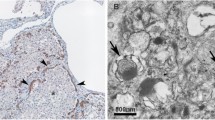Abstract
Objective
To study the relationship between SP-A2 and SP-B gene polymorphisms and respiratory distress syndrome in preterm neonates.
Design
Cross-sectional.
Setting
Neonatal intensive care unit and the Molecular Biology unit of the Chemical Pathology Department, Kasr Alainy hospital, Cairo University.
Participants
Sixty-five preterm infants with respiratory distress syndrome and 50 controls. The genomic DNA was isolated using DNA extraction kits. SYBR Greenbased real-time PCR was used to determine the variant genotypes of SP-A2 c.751 G<A and SP-B c.8714 G<C single nucleotide polymorphisms.
Results
Homozygosity of SP-A (OR 46, 95% CI 14–151) and SP-B (OR 5.2, 95% CI 2.3–11.4) alleles increased the risk of respiratory distress syndrome. The logistic regression model showed that genotypes SP-A2 (OR 164) and SP-B (OR 18) were directly related to the occurrence of respiratory distress syndrome, whereas gestational age (OR 0.57) and 5-minute Apgar score (OR 0.19) were inversely related to its occurrence.
Conclusions
There is a possible involvement of SP-A2 and SP-B genes polymorphisms in the genetic predisposition to respiratory distress syndrome.
Similar content being viewed by others
References
El-Zanaty F. and Way A.: Egypt Demographic and Health Survey. Cairo, Egypt: Ministry of Health and Population, National Population Council, El-Zanaty and Associates, and Macro International; 2008. p.116.
WHO, 2014: Millennium Development Goals. Available from: http://www.who.int/mediacentre/factsheets/fs290/en/ Accessed June 2, 2014
Puthothu B, Forster J, Heinze J, Heinzmann A, Krueger M. Surfactant protein B polymorphisms are associated with severe respiratory syncytial virus infection, but not with asthma. BMC Pulm Med. 2007;11:7:6.
White RT, Damm D, Miller J, Spratt K, Schilling J, Hawgood S, et al. Isolation and characterization of the human pulmonary surfactant apoprotein gene. Nature. 1985;317:361–3.
Katyal SL, Singh M, Locker J. Characterization of a second human pulmonary surfactant-associated protein SP-A gene. Am J Respir Cell Mol Biol. 1992; 6:446–52.
Fisher JH, Kao FT, Jones C, White RT, Benson BJ, Mason RJ. The coding sequence for the 32,000-dalton pulmonary surfactant associated protein A is located on chromosome 10 and identifies two separate restriction-fragment length polymorphisms. Am J Hum Genet. 1987;40:503–11.
Longo ML, Bisagno AM, Zasadzinski JA, Bruni R, Waring AJ. A function of lung surfactant protein SP-B. Science. 1993;261:453–6.
Floros J, Phelps DS. Pulmonary surfactant. In: Biebuyck JF, Lynch C, Maze M, Saidamn Lj, Yaksh TL, Zapol WM, eds, Anesthesia: Biologic Foundations. Lippincott-Raven, New York; 1997. p. 1257–79.
Nogee LM, de Mello DE, Dehner LP, Colten HR. Deficiency of pulmonary surfactant protein B in congenital alveolar proteinosis. N Engl J Med. 1993;328:406–10.
Nogee LM. Surfactant protein-B deficiency. Chest. 1997;111:129S–35S.
Nogee LM, Wert SE, Proffit SA, Hull WM, Whitse.tt JA. Allelic heterogeneity in hereditary surfactant protein B (SP-B) deficiency. Am J Respir Crit Care Med. 2000;161:973–81.
Floros J, Fan R, Matthews A, Diangelo S, Luo J, Nielsen H, et al. Family-based transmission disequilibrium test (TDT) and case-control association studies reveal surfactant protein A (SP-A) susceptibility alleles for respiratory distress syndrome (RDS) and possible race differences. Clin Genet. 2001;60: 178–87.
Ramet M, Haataja R, Marttila R, Floros J, Hallman M. Association between the surfactant protein A (SP-A) gene locus and respiratory-distress syndrome in the Finnish population. Am J Hum Genet. 2000;66:1569–79.
Haataja R, Marttila R, Uimari P, Lofgren J, Ramet M, Hallman M. Respiratory distress syndrome: Evaluation of genetic susceptibility and protection by transmission disequilibrium test. Hum Genet. 2001;109:351–5.
Kirkpatrick B, Mueller D. Respiratory disorders in newborn. In: Chernick V, Boat T, Edwin L (eds) Kendig’s. Disorders of the Respiratory Tract in Children. WB Saunders: Philadelphia, 1988. p. 328–64.
Liu J. Respiratory distress syndrome in full-term neonates. Neonatal Biol. 2012; 2167–0897.
Newman B. Imaging of medical disease of the newborn lung. Radiol Clin North Am. 1999;37:1049–78.
Kinsella JP, Greenough A, Abman SH. Bronchopulmonary dysplasia. Lancet. 2006;367:1421–31.
Lin Z, deMello DE, Wallot M, Floros J. An SP-B gene mutation responsible for SP-B deficiency in fatal congenital alveolar proteinosis: evidence for a mutation hotspot in exon 4. Mol Genet Metab. 1998;64:25–35.
Lin Z, deMello DE, Batanian JR, Khammash HM, Diangelo S, Luo J, et al. Aberrant SP-B mRNA in lung tissue of patients with congenital alveolar proteinosis (CAP). Clin Genet. 2000;57:359–69.
Kala P, Ten Have T, Nielsen H, Dunn M, Floros J. Association of pulmonary surfactant protein A (SP-A) gene and RDS: Interaction with SP-B. Pediatr Res. 1998;43:1–9.
Jo HS, Cho SI, Chang YH, Kim BI, Choi JH. Surfactant protein A associated with respiratory distress syndrome in Korean preterm infants: evidence of ethnic difference. Neonatology. 2013;103:44–7.
Marttila R, Haataja R, Guttentag S, Hallman M. Surfactant protein A and B genetic variants in respiratory distress syndrome in singletons and twins. Am J Respir Crit Care Med. 2003;168:1216–22.
Lyra PP, Diniz EM, Abe-Sandes K, Angelo AL, Machado TM, Cardeal M. Surfactant protein B gene polymorphism in preterm babies with respiratory distress syndrome. Braz J Med Biol Res. 2011;44:66–72.
Author information
Authors and Affiliations
Corresponding author
Rights and permissions
About this article
Cite this article
Abuelhamed, W.A., Zeidan, N., Shahin, W.A. et al. Human surfactant proteins A2 (SP-A2) and B (SP-B) genes as determinants of respiratory distress syndrome. Indian Pediatr 52, 391–394 (2015). https://doi.org/10.1007/s13312-015-0643-9
Received:
Revised:
Accepted:
Published:
Issue Date:
DOI: https://doi.org/10.1007/s13312-015-0643-9




